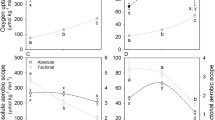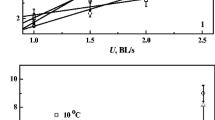Synopsis
Observations on continuously swimming tunas were used to determine effects of temperature upon volitional locomotory activity and to determine upper and lower lethal temperatures. Experimental subjects were 10 skipjack tuna, Katsuwonus pelamis, 9 kawakawa, Euthynnus affinis, and 3 yellowfin tuna, Thunnus albacares.
Our results: lower and upper lethal temperatures for the euthynnids (K. pelamis and E. affinis) were 15° and 33° C, respectively. Swimming speed for the euthynnids did not decrease with temperature within most of the zone of thermal tolerance; we observed either temperature independence or increases in speed as the temperature decreased. Yellowfin tuna swam slower as the water temperature decreased, but swimming speed changes lagged behind the water temperature changes. This effect was most certainly due to the large thermal inertia that is a property of tunas. The lag between swim speed and water temperature was eliminated by utilizing an estimate of red muscle temperature, rather than water temperature, as a covariate. Yellowfin tuna swim speed was best correlated with red muscle temperature rather than ambient water or brain temperatures.
Similar content being viewed by others
References cited
Barrett, I. & F. J. Hester. 1964. Body temperature of yellowfin and skipjack tunas in relation to sea surface temperature. Nature 203: 96–97.
Blackburn, M. 1965. Oceanography and the ecology of tunas. Oceanogr. Mar. Biol. A. Rev. 3: 299–322.
Carey, F. G. & J. M. Teal. 1969. Regulation of body temperature by the bluefin tuna. Comp. Biochem. Physiol. 28: 205–213.
Carey, F. G., J. M. Teal, J. W. Kanwisher, K. D. Lawson & J. S. Beckett. 1971. Warm-bodied fish. Am. Zool. 11: 137–143.
Dizon, A. E., T. C. Byles & E. D. Stevens. 1976. Perception of abrupt temperature decrease by restrained skipjack tuna, Katsuwonus pelamis. J. Therm. Biol. 1: 185–187.
Dizon, A. E., E. D. Stevens, W. H. Neill & J. J. Magnuson. 1974. Sensitivity of restrained skipjack tuna (Katsuwonus pelamis) to abrupt increases in temperature. Comp. Biochem. Physiol. 49A: 291–299.
Gordon, M. S. 1968. Oxygen consumption of red and white muscles from tuna fishes. Science 159: 87–90.
Graham, J. B. 1975. Heat exchange in the yellowfin tuna, Thunnus albacares, and skipjack tuna, Katsuwonus pelamis, and the adaptive significance of elevated body temperatures in scombrid fishes. Fish. Bull., U.S. 73: 219–229.
Hazel, J. R. & C. L. Prosser. 1974. Molecular mechanisms of temperature compensation in poikilotherms. Physiol. Rev. 54: 620–677.
Hollander, M. & D. A. Wolfe. 1973. Nonparametric statistical methods. John Wiley & Sons, New York, 503 pp.
Magnuson, J. J. 1970. Hydrostatic equilibrium of Euthynnus affinis, a pelagic teleost without a gas bladder. Copeia 1970: 56–85.
Magnuson, J. J. 1973. Comparative study of adaptations for continuous swimming and hydrostatic equilibrium of scombroid and xiphoid fishes. Fish. Bull., U.S. 71: 337–356.
Neill, W. H., R. K. C. Chang & A. E. Dizon. 1976. Magnitude and ecological implications of thermal inertia in skipjack tuna, Katsuwonus pelamis (Linnaeus). Env. Biol. Fish. 1: 61–80.
Neill, W. H. & E. D. Stevens. 1974. Thermal inertia versus thermoregulation in ‘warm’ turtles and tunas. Science 184: 1008–1010.
Peterson, R. H. & J. M. Anderson. 1969. Influence of temperature change on spontaneous locomotor activity and oxygen consumption of Atlantic salmon, Salmo salar, acclimated to two temperatures. J. Fish. Res. Board Can. 26: 93–109.
Prosser, C. L. & F. A. Brown, Jr. 1961. Comparative animal physiology. 2d ed. Saunders, Philadelphia, 688 pp.
Steffel, S., A. E. Dizon, J. J. Magnuson & W. H. Neill. 1976. Temperature discrimination by captive free-swimming tuna, Euthynnus affinis. Trans. Am. Fish. Soc. 105: 588–591.
Stevens, E. D. & F. E. J. Fry. 1971. Brain and muscle temperatures in ocean caught and captive skipjack tuna. Comp. Biochem. Physiol. 38A: 203–211.
Stevens, E. D. & F. E. J. Fry. 1972. The effect of changes in ambient temperature on spontaneous activity in skipjack tuna. Comp. Biochem. Physiol. 42A: 803–805.
Webb, P.W. 1974. Hydrodynamics and energetics of fish propulsion. Fish. Res. Board Can., Bull. 190, 159 pp.
Author information
Authors and Affiliations
Rights and permissions
About this article
Cite this article
Dizon, A.E., Neill, W.H. & Magnuson, J.J. Rapid temperature compensation of volitional swimming speeds and lethal temperatures in tropical tunas (Scombridae). Environ Biol Fish 2, 83–92 (1977). https://doi.org/10.1007/BF00001418
Received:
Accepted:
Issue Date:
DOI: https://doi.org/10.1007/BF00001418




